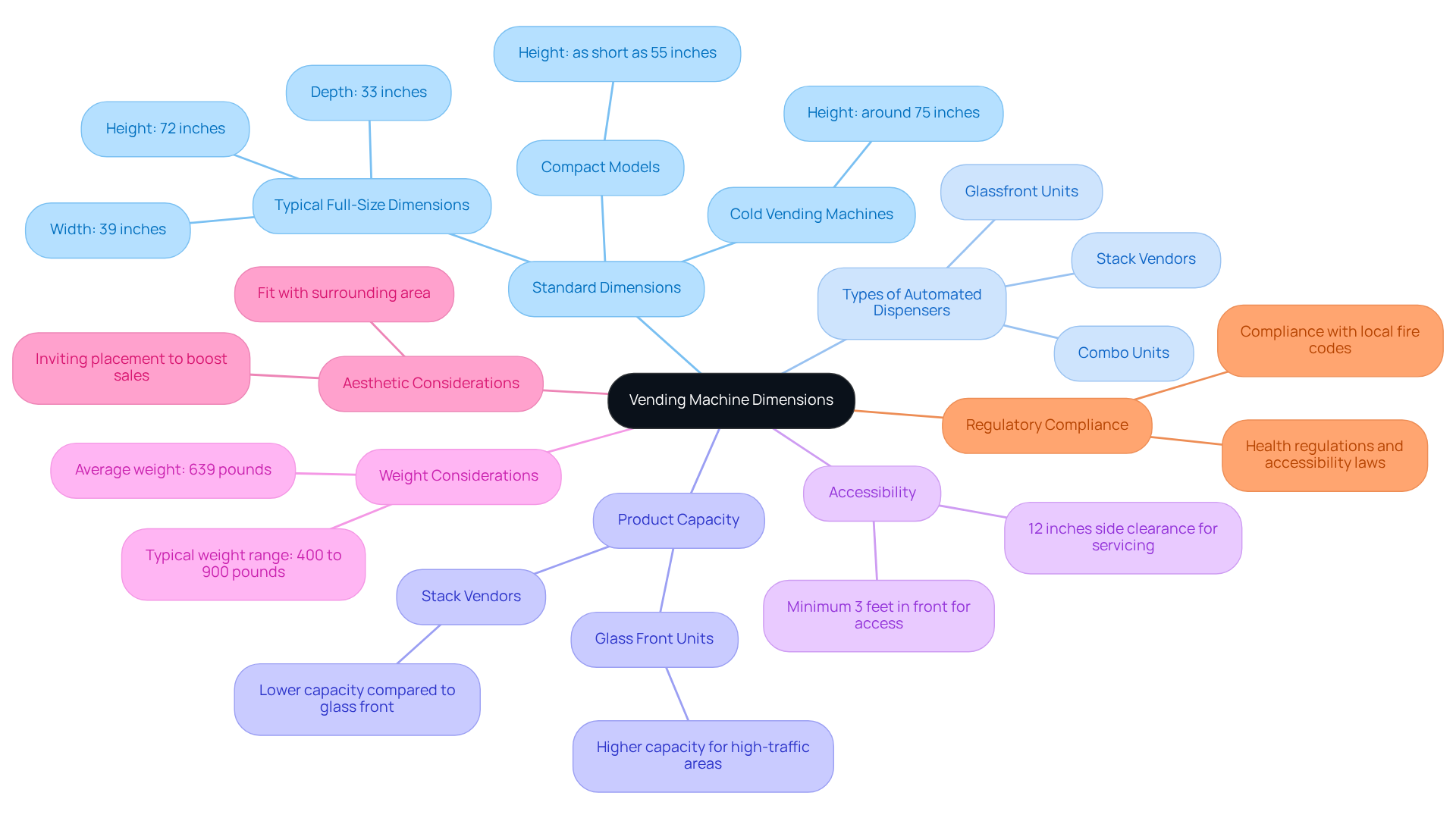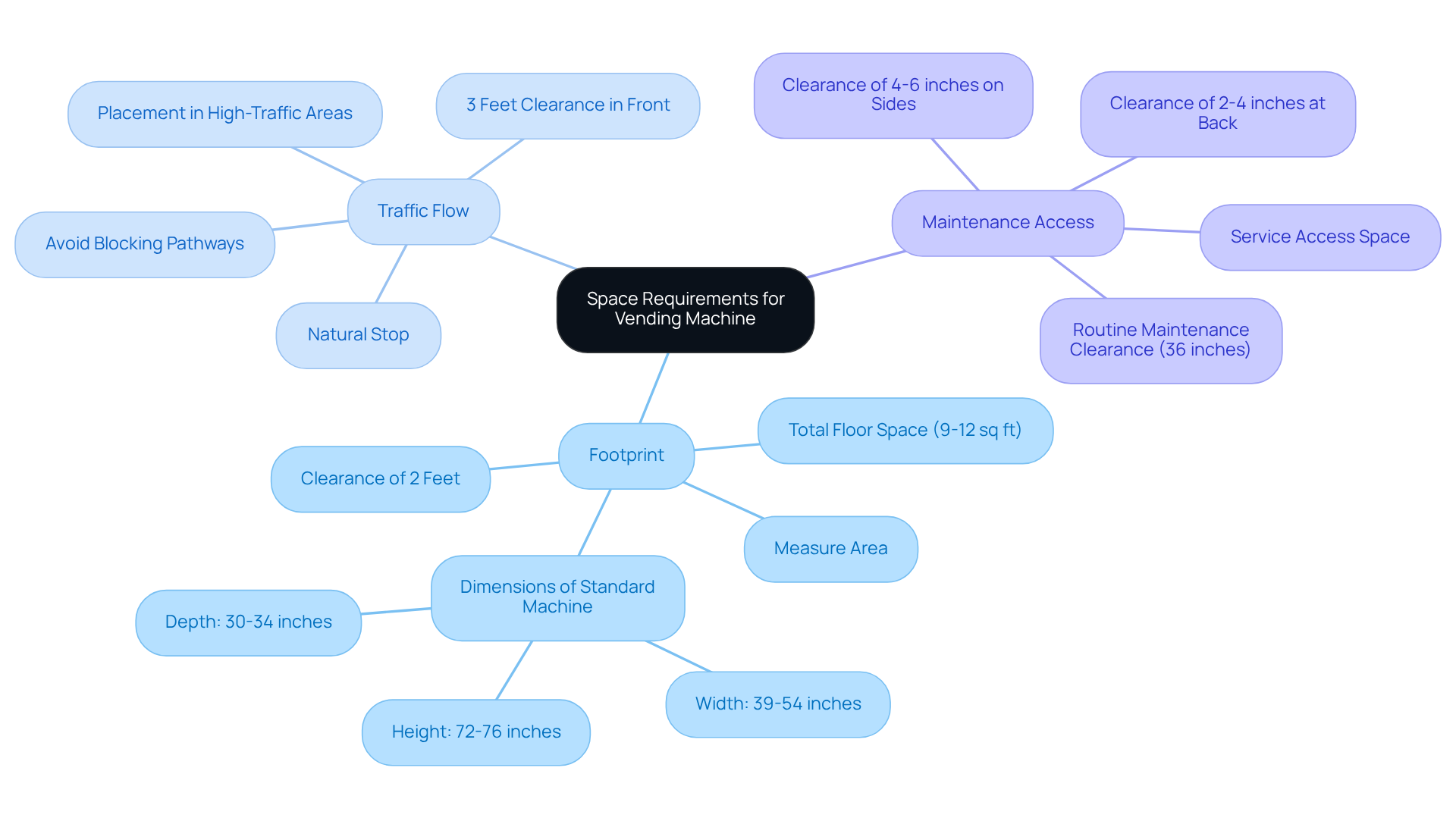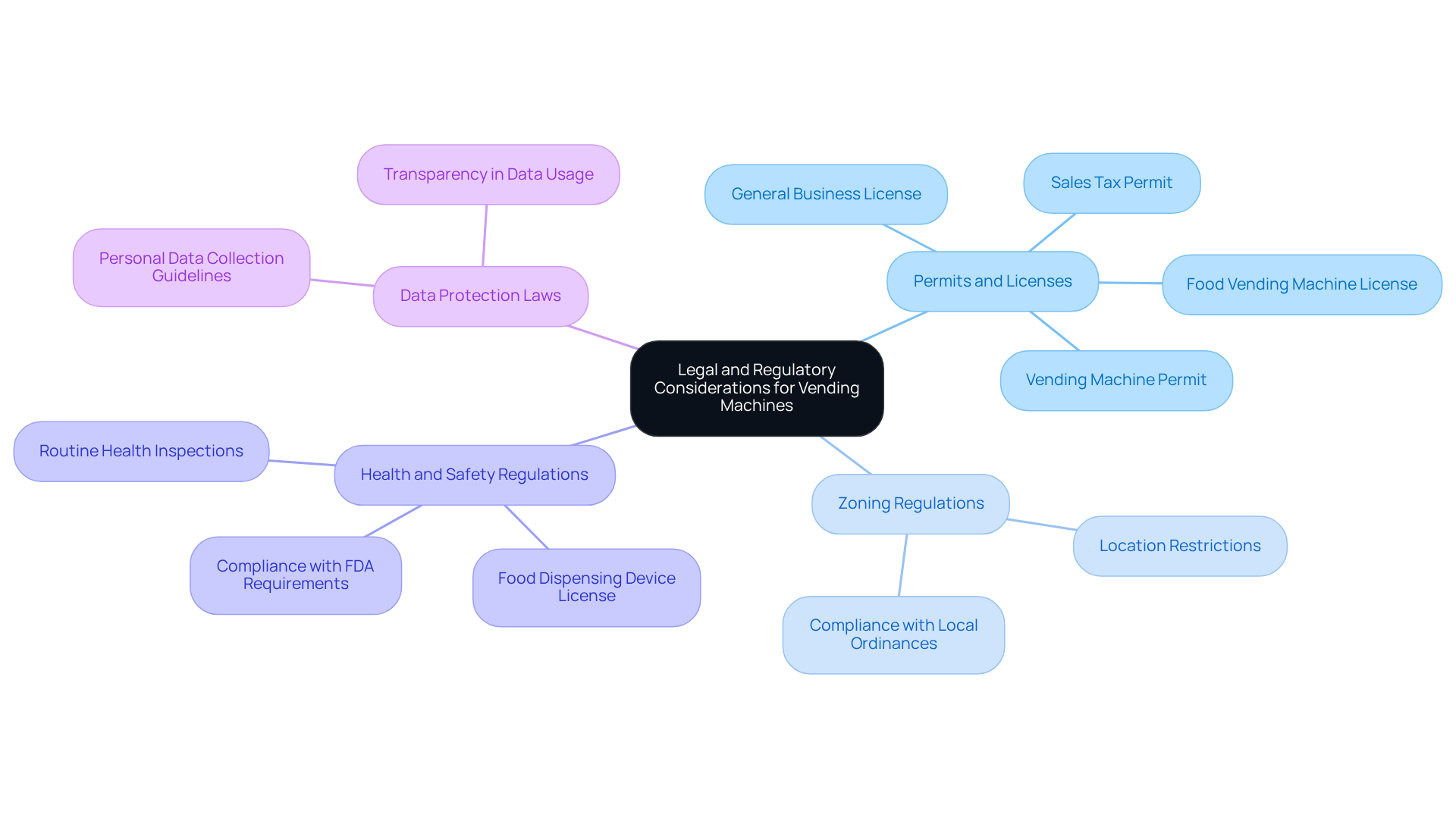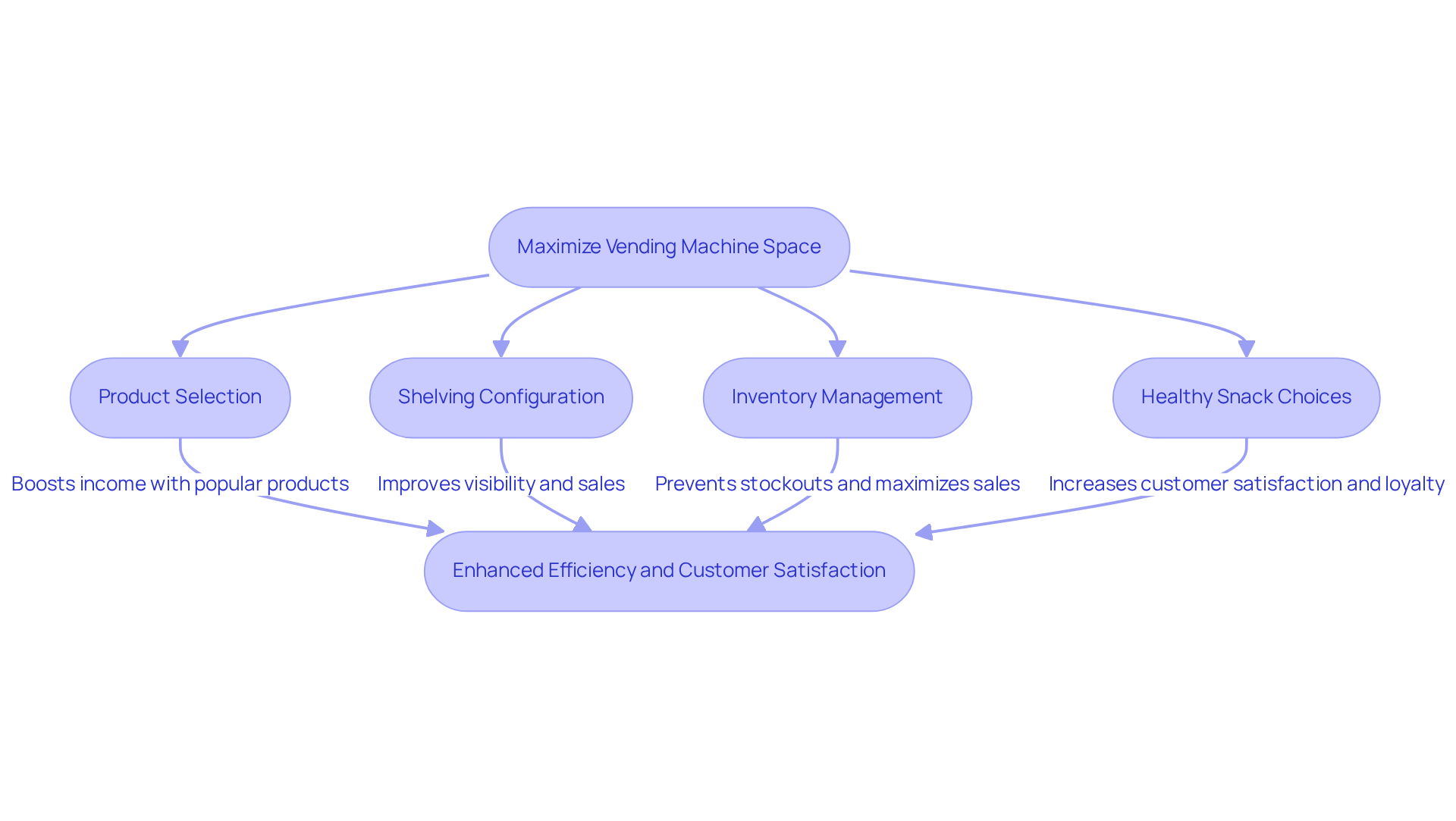Overview
When it comes to vending setups, understanding pop machine dimensions is super important. Why? Because these dimensions directly affect how much product you can fit, how easy it is for customers to access, and whether you’re following the rules.
Here’s the thing: picking the right size and type of vending machine isn’t just about fitting it in your space. You’ve got to think about how it impacts your customers’ experience and your overall efficiency. It’s all about making things work smoothly.
So, take a moment to assess your space and legal obligations. By doing this, you can really enhance how your customers interact with your vending machines. Trust me, it makes a difference!
Introduction
If you're looking to optimize your vending setup, understanding the dimensions of pop machines is key. These machines typically range from 5.5 to 6.5 feet tall, and their widths and depths can vary quite a bit. Choosing the right size can really make a difference in how accessible it is for customers and, ultimately, your sales potential.
But here’s the thing: navigating the complexities of machine size, space requirements, and legal regulations can feel overwhelming. How do you ensure a successful vending operation? This article dives into the essential factors to consider, giving you insights that can lead to smarter decisions and better operational efficiency. So, let’s break it down together!
Explore Vending Machine Dimensions and Their Importance
Pop machine dimensions vary, with vending units typically ranging in size from 5.5 to 6.5 feet tall, 2 to 3 feet wide, and 2 to 3 feet deep. Knowing the pop machine dimensions is essential for selecting the right equipment for your space. Let’s break it down:
Standard Dimensions: Most full-size vending machines are about 72 inches tall, 39 inches wide, and 33 inches deep. For instance, a typical snack dispenser stands around 72 inches high and 39 inches wide, while a beverage unit might be slightly smaller, often around 75 inches tall for cold drinks. If you’re tight on space, compact dispensers can be as short as 55 inches.
Types of Automated Dispensers: There are three main types of automated dispensers:
- Stack vendors
- Glassfront units
- Combo units
Each has its own pop machine dimensions and capacities, which can affect where they fit best.
Product Capacity: The size of the vending machine also impacts how much it can hold. Glass front units, designed for high-traffic areas, can fit a lot more items than traditional stack vendors. More capacity can lead to higher sales, especially in busy spots where lots of customers pass through.
Accessibility: It’s super important that the height of the machine allows everyone to reach the products easily, especially shorter customers or kids. Aim for at least 3 feet of space in front of the machine for easy access, and don’t forget about 12 inches of side clearance for servicing. This makes the whole experience better for everyone and encourages more use.
Weight Considerations: Vending machines typically , so keep that in mind when you’re planning where to put it.
Aesthetic Considerations: The size and style of the machine should fit in with the surrounding area, making the spot more inviting. A well-placed machine that matches its environment can draw in more customers and boost sales.
Regulatory Compliance: Don’t overlook the need for the machines to comply with local fire codes, health regulations, and accessibility laws, especially in public spaces. You might need to get some extra permits or approvals.
By keeping the pop machine dimensions and considerations in mind, you can make smart choices that not only improve customer experience but also enhance your operational efficiency.

Assess Space Requirements for Installation and Maintenance
When you're thinking about where to put a vending machine, there are a few things to keep in mind.
- First up, the footprint. You’ll want to measure the area for the , ensuring it fits comfortably with some extra room for users to access it. A good rule of thumb is to leave at least 2 feet of clearance around the pop machine dimensions.
- Next, let’s talk about traffic flow. Take a look at how people move around the space. You want the machine to be easy to get to without blocking any pathways. It should feel like a natural stop, not an obstacle.
- Don’t forget about maintenance access. Make sure there’s enough space for service folks to get in there for restocking and repairs, taking the pop machine dimensions into account. This might mean leaving some extra room behind or beside the machine. Since your automated dispensers are in great shape and don’t need any repairs right now, planning for maintenance access will help keep them that way.
By keeping these space requirements in mind, you can sidestep installation headaches and keep everything running smoothly. So, take a moment to assess your space before diving in!

Understand Legal and Regulatory Considerations for Vending Machines
Before you dive into installing a vending machine, it’s super important to get a grip on the legal and regulatory landscape. Trust me, this will help you run your operation smoothly.
- Permits and Licenses: First off, check out . You’ll want to know what permits or licenses you need to operate a vending machine in your area. This usually includes health permits, especially if you're selling food. For instance, many states require a general business license, a permit for automatic sales devices, and maybe even a sales tax permit for taxable items.
- Zoning Regulations: Next, let’s talk zoning regulations. You need to make sure you’re following the rules about where you can place . Some areas have restrictions that could affect your location choices. Knowing these regulations is key to avoiding penalties and making sure your equipment is set up legally.
- Health and Safety Regulations: Don’t forget about health and safety standards, particularly for machines that dispense food or drinks. Following these rules is crucial to avoid any legal headaches and keep your customers safe. You might need to pass routine health inspections, and you’ll definitely need a food dispensing device license to operate legally.
By getting a solid understanding of these legal factors, you can navigate the ins and outs of placement confidently, ensuring your business runs within the law and minimizing the risk of penalties. Plus, keep in mind your responsibilities regarding personal data protection. In today’s marketplace, it’s essential to comply with data protection laws. This means knowing how personal data can be collected, used, and shared in connection with your sales operations, ensuring everything is transparent and up to legal standards.

Maximize Vending Machine Space for Operational Efficiency
To really make the most of your vending machine space and keep things running smoothly, let’s dive into some straightforward strategies.
- Product Selection: First off, think about the mix of products you’re offering. You want a variety that speaks to your . Looking at revenue info, it’s clear that popular snacks and drinks, like chips and energy drinks, can really boost your income. In fact, the average vending unit pulls in about $9,336 a year—pretty standard for the industry. So, picking the right products is key.
- Shelving Configuration: Next up, consider your shelving. Adjustable shelving can be a game changer. It lets you fit different item sizes and makes everything easier to see, which can lead to more sales. Remember, well-organized displays tend to attract more customers, so don’t underestimate the power of good shelving.
- Inventory Management: Now, let’s talk about inventory. Using an inventory management system can help you keep tabs on what’s selling and what needs restocking. This proactive approach means you won’t run into stockouts on your best-sellers, which can really hurt your sales. With the automated retail market expected to grow at a 7.5% CAGR from 2023 to 2032, staying on top of your inventory is crucial for staying competitive.
- Healthy Snack Choices: Also, think about adding some healthy snack options. There’s a growing trend towards healthier choices among consumers, and meeting that demand can really boost customer satisfaction and loyalty.
By putting these strategies into action, you can enhance your vending machine’s efficiency, leading to better sales and happier customers.

Conclusion
Let’s face it, understanding the dimensions of pop machines is key to making your vending machines work better for you and your customers. When you know the exact measurements and requirements, you can place your machines where they fit just right and grab attention, all while serving your customers effectively.
Here’s the thing: there are a few important factors to keep in mind. These include:
- Standard dimensions
- Machine types
- Product capacity
- Accessibility
- Compliance with regulations
Each of these elements plays a big role in figuring out the best setup for your vending machine. Don’t forget about the space needed for installation and maintenance, plus any legal considerations. These are crucial for keeping things running smoothly and following local laws.
So, what’s the takeaway? By planning carefully and making smart decisions about your vending machine dimensions, you can boost sales and keep your customers happy. Prioritizing these aspects helps create a welcoming environment that encourages usage and maximizes your revenue potential. Embracing these principles not only makes setup easier but also positions your vending machines as valuable assets in any commercial space.
Frequently Asked Questions
What are the typical dimensions of vending machines?
Vending machines typically range from 5.5 to 6.5 feet tall, 2 to 3 feet wide, and 2 to 3 feet deep. Most full-size vending machines are about 72 inches tall, 39 inches wide, and 33 inches deep.
What types of automated dispensers are there?
There are three main types of automated dispensers: stack vendors, glassfront units, and combo units. Each type has its own dimensions and capacities.
How does the size of a vending machine impact its product capacity?
The size of the vending machine affects how much it can hold. Glass front units, designed for high-traffic areas, can fit more items than traditional stack vendors, potentially leading to higher sales in busy locations.
Why is accessibility important when placing a vending machine?
Accessibility is important to ensure that everyone, including shorter customers and children, can easily reach the products. It is recommended to have at least 3 feet of space in front of the machine and 12 inches of side clearance for servicing.
What should be considered regarding the weight of vending machines?
Vending machines typically weigh between 400 and 900 pounds, which should be taken into account when planning their placement.
How can the aesthetic of a vending machine influence customer interaction?
The size and style of the vending machine should complement the surrounding area, making the space more inviting. A well-placed machine that matches its environment can attract more customers and boost sales.
What regulatory considerations should be kept in mind for vending machines?
It is important to ensure that vending machines comply with local fire codes, health regulations, and accessibility laws, especially in public spaces. Additional permits or approvals may be required.
List of Sources
- Explore Vending Machine Dimensions and Their Importance
- vendinggroup.com (https://vendinggroup.com/coca-cola-vending-machine-size-guide)
- vendinglocator.com (https://vendinglocator.com/blog/vending-machine-dimensions)
- How Tall Are Vending Machines? 2025 Guide (https://vending.sodalemonme.com/en/blogs/how-tall-are-vending-machines?srsltid=AfmBOoou4TrUNGBTLsdEYQ0Go0N20C8Nt3QioSboRHuG82kMr0MYJAxU)
- Vending Machine Statistics and Facts (2025) (https://news.market.us/vending-machine-statistics)
- Assess Space Requirements for Installation and Maintenance
- Vending Machine Setup: How Much Space Do You Really Need? (https://dfyvending.com/vending-machine-installation-space)
- How Much Space Does a Vending Machine Need? - Fraxotic Vending Machines (https://fraxotic.com/how-much-space-does-a-vending-machine-need)
- dfyvending.com (https://dfyvending.com/vending-machine-space-requirements)
- Understand Legal and Regulatory Considerations for Vending Machines
- How to Get a Vending Machine License or Permit | Vending.com (https://vending.com/blog/how-to-get-a-vending-license)
- What Permits Are Required to Start a Vending Machine Business? (https://dfyvending.com/vending-machine-business-permits)
- Vending Regulations by State | Vending Permit Requirements (https://candymachines.com/Vending-Regulations-by-State.aspx?srsltid=AfmBOop7wZQSVC4s51J3DffklAeoN1GperbW3wyzc-wx_7nvwA-8bShg)
- Vending Machine Statistics in 2023 - Vending Locator (https://vendinglocator.com/blog/vending-machine-statistics)
- Vending Machine Statistics and Facts (2025) (https://news.market.us/vending-machine-statistics)
- Maximize Vending Machine Space for Operational Efficiency
- 2025 Vending Machine Profit Statistics: How Much Can You Make? (https://smallbizgenius.net/by-the-numbers/vending-machine-profit-statistics)
- Vending Machine Market Size And Size ,Trends ,Statistics 2032 (https://alliedmarketresearch.com/vending-machine-market-A09486)
- Vending Machine Statistics in 2023 - Vending Locator (https://vendinglocator.com/blog/vending-machine-statistics)
- Healthy Vending Industry Research | Healthy Vending Market | Naturals2Go (https://naturals2go.com/vending-machine-business/buying-a-vending-machine/healthy-vending-market)
- Vending Machine Market Report 2025-2033: Increasing Convenience and Availability of Diverse Product Range Fueling Expansion (https://globenewswire.com/news-release/2025/03/27/3050765/0/en/Vending-Machine-Market-Report-2025-2033-Increasing-Convenience-and-Availability-of-Diverse-Product-Range-Fueling-Expansion.html)




